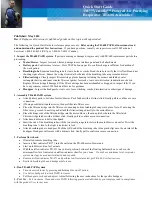
10
XT1
Figure 6.1
Figure 6.2 shows the power supply terminal of the indoor unit.
VP30
Heat insulation
material
Slope > 1/100
Bending
Sloping downwards
1/100 or more
As large as possible
(about 10 cm)
Wire slot
Indoor power
supply
Outdoor power
supply
Indoor unit
Communication wire between
indoor and outdoor units
Grounding line
RCCB
RCCB
POWER IN
L
N
5.
Water Discharge Piping Installation
5.1.
Indoor Unit Water Discharge Piping Installation
1. Use
PVC
pipes
as
water
discharge
pipes
(outer
diameter:
37~39
mm,
inner
diameter:
32
mm).
Based
on
the
actual
installation
circumstances, users
can
purchase
the
appropriate
piping
length
from
their
sales
agent,
local
service centre or purchase them directly from the
local market.
2.
Insert
the
water
discharge
pipe
into
the
end
of
the
water
suction
connection pipe
of
the
unit
body,
and
use
the
ring
clamp
to
clamp
the
water
discharge pipes together
with
the
insulation
sleeve
for
the
water
outlet
3.
Use
the
insulation
sleeve
of the
water
discharge
piping to
tie
the
water
suction
and
discharge
pipes
of
the
indoor
unit
(especially
the
indoor
section)
together, and securely
tie
for
the
water
discharge
pipe with a cable tie to
ensure that air does
not
enter
and
condense.
4. In
order
to
prevent water from returning to the
air
conditioner
when
the
operation
is stopped,
the
water
discharge
pipe
should
slope
downwards
towards
the
outside
(drainage
side) and the slope angle
shouldn
'
t
be greater than
1/100.
Make
sure
that
the
water
discharge
pipe
does
not
swell
or
collect
water; otherwise, it will cause strange
noises. See Figure 5.1.
5. When
connecting
the
water
discharge
piping,
do
not pull
the
pipes
to
prevent
the
water
suction
pipe
connector
from loosening.
At
the
same
time,
set
a
support
point
at
every
0.8~1 m
to prevent the water discharge
pipes from bending. See Figure 5.1.
Folding
Figure 5.1
6. When
connecting
to
a
long
water
discharge
pipe,
the
connections
must
be
covered
with
a
insulating
sleeve
to
prevent
the
long
pipe
from
loosening.
7. When
the
water
discharge
pipe outlet
is
higher
than
the
water
suction
pipe connection,
try
to
keep
the
water
discharge
pipe
as
vertical
as
possible
and
the
water
outlet
connection
fittings
will
be bent
so
that
the
height of
the
water
discharge
pipe
should
be
within
1000
mm
from
the
base of
the
drain
pan.
Otherwise,
there
will
be
excessive
water
flow
when
operation stops. See Figure 5.2.
Figure 5.2 Centralised water discharge
8. The
end
of
the
water
discharge
pipe
must
be
at least
50
mm
above
the
ground
or
the
base
of
the
water
discharge
slot.
In addition,
do
not
put
it
in the water.
Caution
•
Make sure all the connections in the piping system are properly
sealed to prevent water leaks.
5.2
Water Discharge Test
Before
testing,
make
sure
that
the
water
discharge
pipe
is
smooth and check if each connection is properly sealed.
Conduct the water discharge test once the unit is installed.
1. Use
the
water
injection
pipe
to
inject
500
~
1000
ml
of
water
into
the water pan.
2.
Check if the
water
discharge
piping
outlet
drains
water
properly and if there are any water leaks at each joint.
6.
Electrical Wiring
Warning
•
All
the
supplied
parts,
materials
and
electrical
works
must
comply
with
local
regulations.
•
Use only copper wires.
•
Use
a
dedicated
power
supply
for
the
air-conditioners.
The
power
voltage
must be in line with the rated voltage.
•
The
electrical
wiring
works
must
be
carried
out
by
a
professional
technician,
and must comply with the labels stated in the circuit diagram.
•
Before
the
electrical
connection
works
are
carried
out,
turn
off
the
power
supply to prevent injuries caused by electric shock.
•
The
external
power
supply
circuit
of
the
air
conditioner
must
include
an
earth
line,
and
the
earth
line
of
the
power
cord
connecting
to
the
indoor
unit
must
be
securely
connected
to
the
earth
line
of the
external
power
supply.
•
Leakage
protective
devices
must
be
configured
according
to
the
local
technical standards and requirements for electrical and electronic devices.
•
The
fixed
wiring
connected
must
be
equipped
with
an
all-pole
disconnection
device with at least 3 mm contact separation.
•
The
distance
between
the
power
cord
and
signalling
line
must
be
at
least
300
mm
to
prevent
the
electrical
interference,
malfunction
or damage
to
electrical
c om ponents. On the other hand,
this
lin es
mu st
not
come in contact with the piping and valves.
•
Choose
electrical
wiring
that
is in conformity with
the
corresponding
electrical requirements.
•
Connect
to
the
power
supply
only
after
all
the
wiring
and
connection
works
have been completed and carefully checked.
6.1
Power Cord Connection
0.8~
1.0 m
Use
a
dedicated
power
supply
for
the
indoor
unit
that
is
different
from
the
outdoor unit's.
Use
the
same
power
supply,
circuit
breaker
and
leakage
safety
device for
the indoor units connected to the same outdoor unit.
Grounding
Figure 6.2
When
connecting
to
the
power
supply
terminal,
use
the
circular
wiring
terminal
with the insulation sleeve (see Figure 6.3).
If
the circular
wiring
terminal
with
the
insulation
sleeve
cannot
be
used,
please
make sure that:
•
Two
power
cords
with
different
diameters are not connected
to
the
same
power supply terminal (may cause the wires to overheat). See Figure 6.4.
•
A power
cord
in conformity with the
specifications is used
and that the
power cord is connected
firmly.
To
prevent
the
cord
from
being
pulled
by
external
force,
make sure it is securely fixed.









































